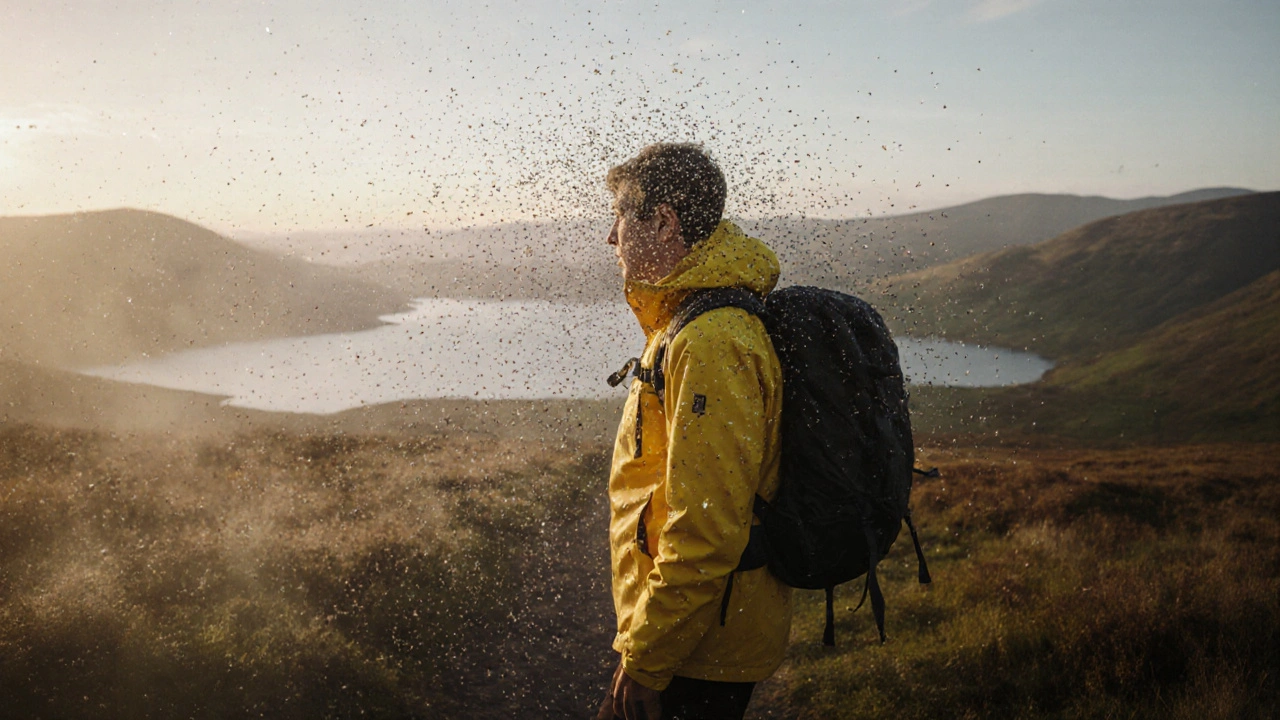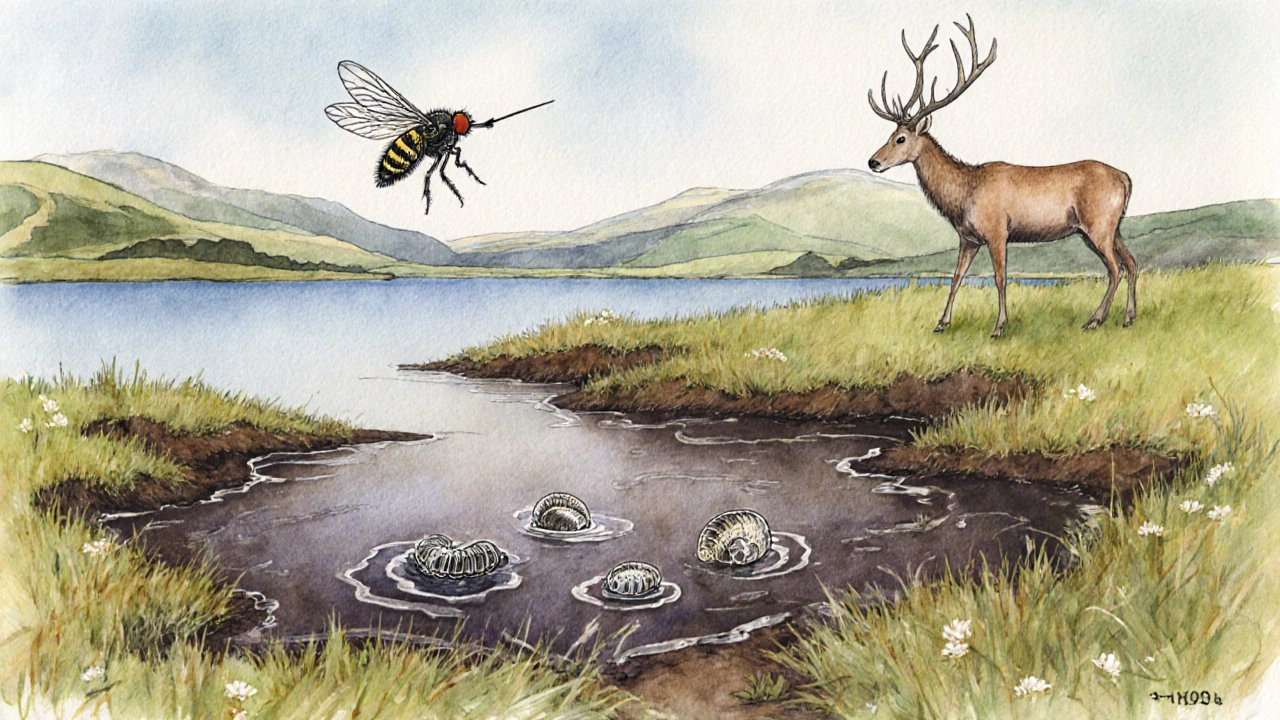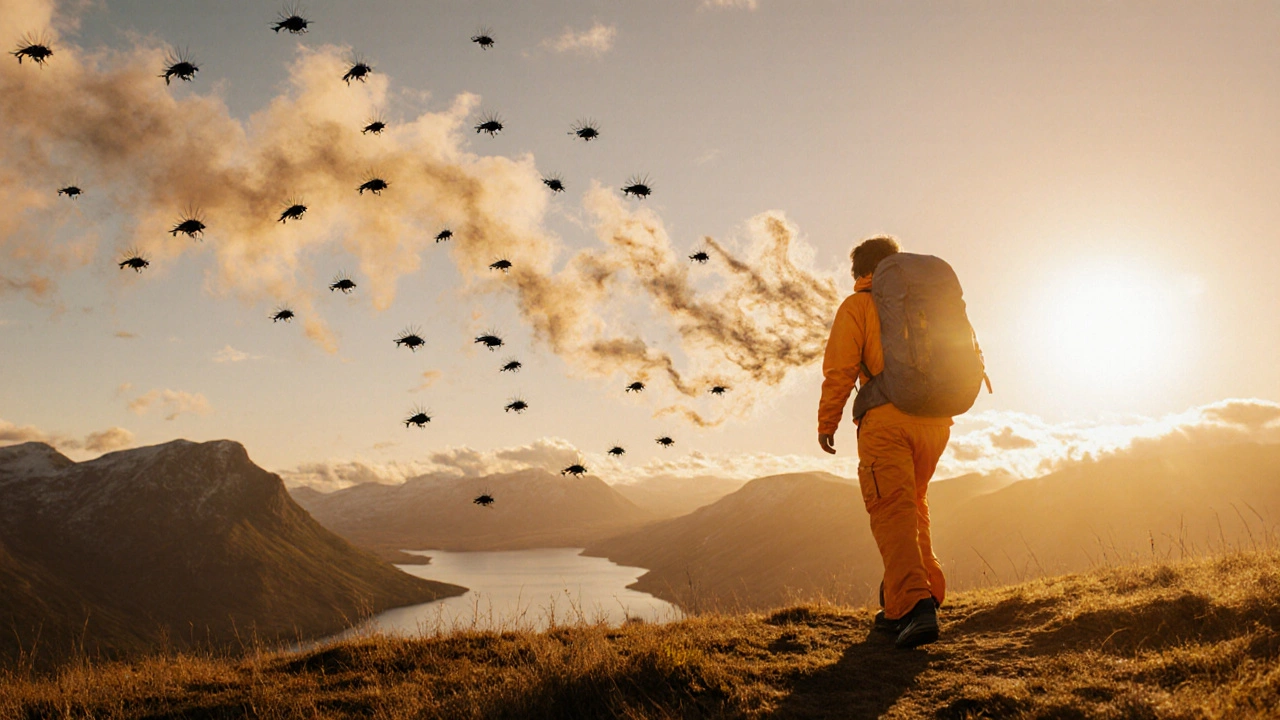
If you’ve ever shivered under a cloud of tiny insects on a misty Highland path, you’ve probably wondered: what are these pests and why do they seem to love Scotland? The answer lies in the humble Midge is a tiny, flying insect belonging to the family Culicoides. In Scotland they’re more than a nuisance; they’re a seasonal phenomenon that can shape where you go, what you wear, and how long you stay outdoors.
What exactly are midges?
Midges are small blood‑feeding flies, usually 1‑3 mm long, that belong to the genus Culicoides impunctatus, the most common biting species in the British Isles. Their life cycle includes egg, larva, pupa and adult stages, all of which occur near water or moist soil. Adult females need a blood meal to develop eggs, which is why they target warm‑blooded hosts - humans, deer, sheep, you name it.
Where do Scottish midges thrive?
Scotland’s geography creates perfect breeding grounds. The Highland region, especially around lochs, burns and peat bogs, holds the highest concentrations. Iconic spots like Loch Lomond, the Glenfinnan viaduct area, and the broader Scottish Highlands are notorious for swarms. Even coastal cliffs can see midges if there’s enough damp ground.
When is the midge season?
The peak period runs from late May to early September, with July and August being the worst. Temperature is the key driver - once it hits about 15 °C (59 °F) for a few days, the females emerge in massive numbers. Early mornings and evenings are prime biting times, as the insects are most active in low light and high humidity.
Why do they bite us?
Female midges need protein from blood to mature their eggs. They’re attracted by carbon dioxide, body heat and certain scents (like sweat). Unlike mosquitoes, they don’t probe deeply; their needle‑like proboscis makes a quick puncture, delivering saliva that contains anticoagulants. Those proteins trigger the familiar itchy welts that can last days.

Health impact - should you worry?
For most visitors, midge bites are a minor irritation. However, in rare cases, the saliva can cause allergic reactions ranging from mild redness to larger hives. Historically, some midges transmit the Bluetongue virus to livestock, but there’s no evidence of serious disease transmission to humans in Scotland.
How to protect yourself
Prevention beats itching every time. Here are proven tactics:
- Dress smart: Wear long sleeves, high collars and tight‑woven fabrics. Anti‑midge clothing treated with permethrin is especially effective.
- Apply midge repellent on exposed skin. Products containing DEET, icaridin or citriodora oil work best.
- Keep moving: Midges struggle to navigate fast‑moving air, so a brisk walk reduces bites.
- Avoid scented lotions, perfumes or strong deodorants that act like a beacon.
- Use midge traps at campsites - carbon‑dioxide or light‑based traps draw them away from you.
Best places and times to enjoy Scotland without the bite
If you can’t avoid midges entirely, you can still savor Scotland’s beauty. Head to higher elevations (above 500 m) where the wind is steadier. Early morning hikes on the Highland plateau before mid‑day sunshine often mean fewer insects. Coastal walks along the Inner Hebrides or the Isle of Skye can be breezy, reducing midge density. Late September, after the first frosts, sees a sharp decline.

Dealing with bites
When you do get bitten, the goal is to stop the itch and prevent infection:
- Wash the area with mild soap and cool water.
- Apply a cold compress or chilled tea bags to reduce swelling.
- Use a topical antihistamine cream (e.g., hydrocortisone 1%).
- Avoid scratching - it can open the skin to bacteria.
- If swelling spreads or you develop hives, seek medical advice.
Common myths about Scottish midges
Myth #1: “Midges only bite tourists.” False - they’re indiscriminate and will bite anyone, locals included.
Myth #2: “You can outrun them.” While speed helps, they can still land on you if you pause.
Myth #3: “Midge bites are contagious.” No - each bite is an independent event; you can’t catch a bite from another person’s welts.
Quick reference checklist
| Aspect | Detail |
|---|---|
| Scientific name (main species) | Culicoides impunctatus |
| Size | 1-3 mm |
| Peak season | July‑August |
| Preferred habitat | Moist peat, lochsides, riverbanks |
| Effective repellents | DEET, icaridin, citriodora oil |
Frequently Asked Questions
Why are midges more common in the Highlands than in the Lowlands?
The Highlands offer cooler, wetter microclimates and abundant peat bogs - ideal breeding sites for Culicoides larvae. Lower elevations tend to be drier and windier, which limits larval survival.
Can I eat midges?
In some cultures midges are harvested as a protein source, but they’re not part of traditional Scottish cuisine. For tourists, it’s best to leave them alone.
Do midges bite animals as well as people?
Yes. Sheep, deer and cattle are primary hosts, which is why farmers often report heavy midge activity on pastures during summer.
Is there any natural way to keep midges away?
Strong winds and bright sunlight deter them. Planting aromatic herbs like lavender or rosemary around camp sites can also reduce their presence, though the effect is modest compared to chemical repellents.
What should I do if I have a severe allergic reaction to a bite?
Seek immediate medical attention. An epinephrine auto‑injector (EpiPen) may be prescribed for those with known severe reactions.
Comments (9)
-
allison berroteran October 23, 2025
Exploring the Highlands often feels like stepping into a living laboratory where the tiniest organisms can have a surprisingly large impact on our experience. The ubiquitous Culicoides impunctatus, more affectionately known as the Scottish midge, is not merely a nuisance but a bio‑indicator of the health of peatlands and freshwater ecosystems. Their life cycle, which begins in the damp soil of lochsides and terminates with a brief, blood‑feeding adult stage, underscores how intimately they are tied to the very landscapes that draw tourists from around the world. When you notice a cloud of these insects swirling around a fire‑lit campsite, it is a reminder that the micro‑climate is humid enough to sustain their larvae, and that the local vegetation is providing a refuge for them. The timing of their emergence, triggered by temperatures hovering around fifteen degrees Celsius for several consecutive days, aligns with the peak of the summer tourist season, creating a perfect storm of human‑insect interaction. While their bites may leave itchy welts, the proteins in their saliva also serve a vital evolutionary function, ensuring the next generation of midges can develop. From a broader perspective, the presence of massive swarms can influence hiking patterns, prompting visitors to adapt their routes, clothing, and timing, which in turn reduces trampling of sensitive alpine flora. Moreover, the very fact that midges thrive in these conditions can be used by conservationists to monitor the health of peat bogs, which are crucial carbon sinks in the fight against climate change. Protecting those habitats not only safeguards biodiversity but also helps mitigate greenhouse gas emissions on a global scale. As someone who has trekked across the Cairngorms with a well‑packed repellent kit, I can attest that a simple change-like opting for a high‑collar, permethrin‑treated shirt-can transform an irritating encounter into a manageable one. The key is to treat midges as a part of the ecosystem rather than an external threat; this mindset encourages respect for the delicate balance that makes Scotland’s scenery so unique. In addition, using wind‑breaks, moving at a brisk pace, and avoiding scented toiletries are low‑tech strategies that complement chemical repellents. If you ever find yourself stuck in a particularly dense swarm, a brief pause in an open, breezy area often disperses the insects naturally. Learning to read the subtle cues-such as a sudden drop in temperature or a rise in humidity-can also give you a heads‑up before the midges appear in full force. Ultimately, embracing these practical habits not only enhances personal comfort but also deepens your connection to the land, turning a potentially pesky situation into an educational moment about the intricate web of life that defines the Scottish Highlands.
-
Gabby Love October 23, 2025
One practical tip is to apply repellent to both skin and clothing, focusing on the ankles and wrists where midges tend to land first. DEET concentrations of 20‑30% are sufficient for most outdoor activities, while icaridin offers a less oily feel with comparable efficacy. For those who prefer natural options, citronella oil blends can provide modest protection, especially when combined with a physical barrier like a fine‑mesh net. Remember to reapply every two to three hours, especially after sweating or after a quick rain shower.
-
Jen Kay October 23, 2025
It is truly astonishing how many tourists cling to the myth that standing still will make midges magically disappear, as if the insects possess a sense of etiquette. In reality, a modest breeze generated by a brisk walk is far more effective at keeping the tiny pests at bay. One might also consider that the very notion of “out‑running” a creature that can hover in place is, frankly, a delightful exercise in futility. Nevertheless, acknowledging these facts can spare visitors from needless frustration.
-
Michael Thomas October 24, 2025
Midges are just another excuse for lazy tour guides to overprice trips.
-
Abert Canada October 24, 2025
Look, if you’re going to blame midges for inflated prices, you’re missing the point that they’re a natural part of the landscape. The real issue is the lack of proper planning by tour operators who sell you a “midge‑free” experience without delivering. Better gear and timing will save you more money than any complaint about insects.
-
Xavier Lévesque October 24, 2025
So you think a quick sprint solves the problem? Sure, if you enjoy looking like a frantic rabbit in the middle of a loch. Perhaps investing in a decent repellent is a smarter move than pretending speed is a magical shield.
-
Thabo mangena October 24, 2025
When considering a visit to Scotland, it is worthwhile to emphasize that the presence of midges does not diminish the country's natural beauty. With thoughtful preparation-such as choosing higher elevations or early‑morning hikes-travellers can enjoy breathtaking vistas with minimal irritation. The resilience of the Scottish people and their willingness to share practical advice further enhances the experience. Moreover, the cultural heritage of the Highlands, from historic castles to vibrant festivals, provides ample distraction from any temporary discomfort. Embracing the challenge of midges can even become a memorable story to recount on future journeys.
-
Karl Fisher October 24, 2025
Ah, the midges! Those tiny winged wonders that add a dash of drama to every Scottish adventure. I’ve learned to love them almost as much as the whisky, especially when they give me an excuse to break out my trusty, neon‑green, anti‑midge shirt. Nothing like a good bite to remind you that you’re truly alive in the wild! So, pack your repellent, wear your brightest colors, and let the Highlands entertain you.
-
Buddy Faith October 24, 2025
They don’t want you to know the real reason midges bite. It’s a government test.
